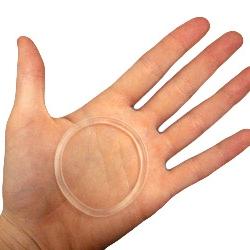What is the vaginal ring?
The vaginal ring (NuvaRing) is a flexible transparent plastic ring about two inches in diameter. It is inserted in the vagina where it releases hormones to prevent pregnancy.
How does it work?
The vaginal ring is inserted and stays in the vagina for three weeks at a time. It releases estrogen and progestin, the same hormones found in a birth control pill. The hormones prevent the ovaries from releasing eggs and thicken the cervical mucus, blocking the sperm from fertilizing an egg.
How effective is the vaginal ring?
9 out of 100 users will get pregnant each year.
What are the benefits?
- It is safe, convenient and effective.
- You do not have to think about birth control every day or every time you have sex.
- Users may have lighter, shorter, more regular and less painful periods.
- Can be used to control timing of your period and/or to keep you from getting a monthly period by skipping the one week break.
- It is quickly reversible and can be stopped at any time if you want to get pregnant.
- Some potential health benefits include protection against acne, iron deficiency anemia, and ovarian cancers.
What are the downsides?
- The vaginal ring does not provide protection from sexually transmitted infections (STI). External condoms or internal condoms can be used to prevent STI.
- You need to remember to refill your prescription regularly.
- Some users may have spotting (bleeding between periods), breast tenderness, nausea and vomiting during the first two to three months of use.
- After stopping the ring, it may take one to two months for periods to return to normal.
- It is a hormonal method, and may have the same side effects as the oral pill.
What are the health risks?
The ring is safe for most users. Methods containing estrogen and progestin have a greater risk of certain problems including heart attack, stroke, blood clots, or developing high blood pressure, liver tumors, gallstones, or yellowing of the skin or eyes (jaundice). The risk increases if you smoke, are age 35 or older, are very overweight, have certain inherited blood-clotting disorders, have diabetes, have high blood pressure, have high cholesterol, or need prolonged bed rest. People with certain health risks should not use the ring.
How do I use it?
- Wash your hands with soap and water.
- Press the sides of the ring together and gently push the ring into your vagina.
- Keep the ring inserted for three weeks.
- Remove the ring the fourth week. This is the week you should expect to get your period.
- To remove the ring, hook your finger on the forward rim and slowly pull it out of the vagina.
- Put the used ring into a plastic bag and throw it away. DO NOT flush it down the toilet.
- After the one week break ends, insert a new ring on the same day of the week the previous ring was inserted.
Important tips
- If the ring slips out at any time, rinse it with cold water and reinsert it within three hours. If it is out for longer than three hours, use a back-up method for the next seven days and see instructions on NuvaRing website.
- You can remove the ring for up to three hours if you are worried about discomfort for you or your partner during sex. Make certain to wash and reinsert it within three hours.
- If you are still experiencing some of the common side effects after two to three months of use, talk to your health care provider.
Where can I get it and what are costs?
You can get a prescription for the ring at UHS, and you can purchase it at the UHS Pharmacy or another pharmacy. Video visits are available for contraception counseling and prescription of this method. To schedule, call 734-764-8320 or see How to Get Health Care. See also Cost, Insurance and Payment.
Personal experiences
I really like using the ring, because I don't have to remember to do something every day (like taking a pill), which I struggle with personally.
Where can I get more information?
Talk to your health care provider. You can also get reliable information from Planned Parenthood.

